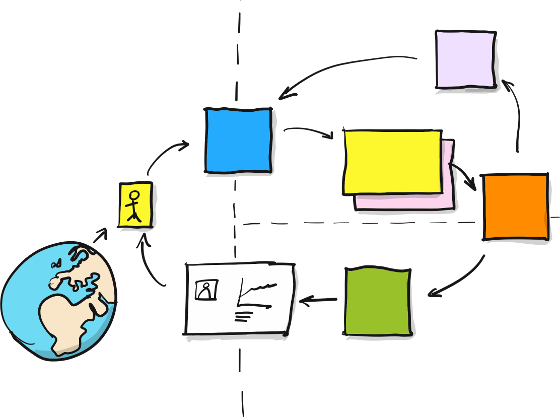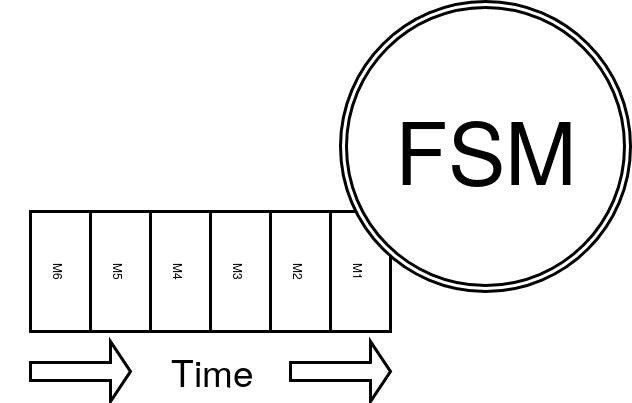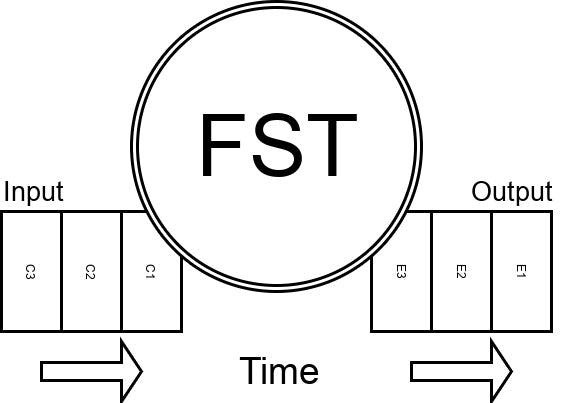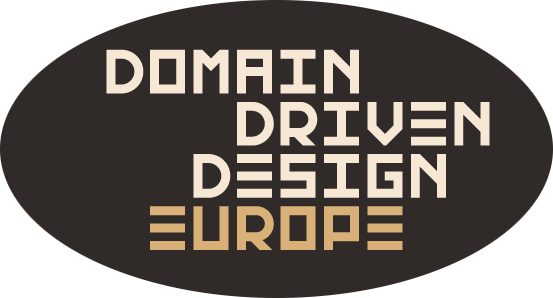Functional Aggregate Design
Processes, Temporality & Automata Theory
Thomas Ploch
Principal Engineer @
With
Scala 3
Code
Examples
0. Outlook
0. Outlook
-
Processes & Process Theories
-
State Machines & Transducers
-
Example Domain & Code
-
Summary
1. Processes & Process Theories
1. Processes & Process Theories
Definition of a process
A process is a series or set of activities that interact to produce a result.
It may occur once-only or be recurrent or periodic.
Definition of a process
1. Processes & Process Theories
A process is a series or set of activities that interact to produce a result.
It may occur once-only or be recurrent or periodic.
sequential
parallel
goal-oriented
multiple actors
temporal
Definition of a process
1. Processes & Process Theories
Definition of a process theory
1. Processes & Process Theories
A process theory is a system of ideas that explains how an entity changes and develops.
Definition of a process theory
1. Processes & Process Theories
A process theory is a system of ideas that explains how an entity changes and develops.
made-up & unvalidated
communication tool
changes over time
Definition of a process theory
Variance theories focus on why something happens.
has identity
1. Processes & Process Theories
Dr. Arlyn Melcher (2013): https://drarlynmelcher.wordpress.com/traditional-variance-theory-dynamics-theory-and-process-theory/
structure
Process theories focus on how something happens.
Temporality in Process Theories
1. Processes & Process Theories
Temporality in Process Theories
1. Processes & Process Theories
Variance theories assume a static point in time and ask "Why are we here? What configuration of variables determined ending up in the observed state?"
Variance
System state at a specific point in time
Variable 1
Variable 2
Variable n
Process
Outcome 1
Outcome 2
Outcome 3
Outcome n
Process theories assume a longitudinal time and ask "How can we get there? What is the sequence of outcomes needed to arrive at the desired state?"
Time is longitudinal - it flows from left to right
1. Processes & Process Theories
Process Theory Archetypes
Process Theory Archetypes
Evolutionary
Explaining change in a population through variation, selection and retention. I.e. biological evolution.
1. Processes & Process Theories
Process Theory Archetypes
Evolutionary
Explaining change in a population through variation, selection and retention.
I.e. biological evolution.
Dialectic
Explaining stability and change by reference to the balance of power between opposing entities. I.e. "How would it be possible that Trump wins in 2024?".
1. Processes & Process Theories
Process Theory Archetypes
Evolutionary
Explaining change in a population through variation, selection and retention.
I.e. biological evolution.
Dialectic
Explaining stability and change by reference to the balance of power between opposing entities. I.e. "what would happen if Trump wins 2024?".
Teleological
Constructing an envisioned end state, taking action to reach it and monitoring the progress. I.e. forming a plan for a "Digital Transformation".
1. Processes & Process Theories
Process Theory Archetypes
Evolutionary
Explaining change in a population through variation, selection and retention.
I.e. biological evolution.
Dialectic
Explaining stability and change by reference to the balance of power between opposing entities. I.e. "how could it happen that Trump wins in 2024?".
Teleological
Constructing an envisioned end state, taking action to reach it and monitoring the progress. I.e. forming a plan for a "Digital Transformation".
Life-cycle
The trajectory to the final end state is prefigured and requires a particular historical sequence of events. Change always conforms to the same series of activities, stages, phases, like a caterpillar transforming into a butterfly.
Or a Software System!
1. Processes & Process Theories
Life-cycle

sequential
multiple actors
communication tool
temporal
made-up
changes over time
Image: Avanscoperta S.r.l https://www.avanscoperta.it/en/training/eventstorming-workshop-facilitation/
When we engage in modelling techniques like Event-Storming or Domain-Story-Telling,
we actually form
Lifecycle process theories!
Command
Aggregate
Event
Read
Model
Policy
has identity
1. Processes & Process Theories
structure
1. Processes & Life-cycle Process Theory
Definition of an Aggregate
...in the context of this presentation!
Aggregate implementations are small experiments to validate our life-cycle process theories, manifested in our systems as executable code.
1. Processes & Life-cycle Process Theory
Definition of an Aggregate
2. State Machines & Transducers
2. State Machines & Transducers
Definition of a State Machine
2. State Machines & Transducers
A Finite-State Machine (FSM) describes the processes during which information moves from one state to another for action, according to a set of rules.
Definition of a State Machine
2. State Machines & Transducers
A Finite-State Machine (FSM) describes the processes during which information moves from one state to another for action, according to a set of rules.
Definition of a State Machine
2. State Machines & Transducers
Definition of a State Machine
FSMs are sequential, event-driven and behavioral models that guarantee consistency and handle concurrency via the Run-To-Completion model.
It seems that they map very well to what we assume in our life-cycle process theories.
2. State Machines & Transducers
Definition of a State Machine
-
Are a great fit to model processes.
-
Drastically cut down the number of execution paths through the code.
-
Simplify the conditions at each branching point.
- Lend themselves well to functional programming.
Using reactive programming without an underlying FSM model can lead to error prone, difficult to extend and excessively complex application code.
State Machines...
2. State Machines & Transducers
Limitations
There are no silver bullets!
2. State Machines & Transducers
Limitations
-
Parallel processing
Since (almost) all State Machine formalisms assume the RTC model (only one message can be processed at a time), there is no way to accommodate parallel processing. This would invalidate the machines' consistency guarantees.
-
Supporting random ordering of messages
All transitions have to be predefined, so scenarios in which messages can be received in any order result in a explosion of states that have to be encoded explicitly to represent all the possible combinations.
2. State Machines & Transducers
But what is a Transducer?
2. State Machines & Transducers
But what is a Transducer?


A FSM cannot provide any useful output, hence they are also called Acceptors - they can only determine if a sequence of inputs is valid.
A FST provides output signals in addition to state changes. That's what we need to send Events back to the system.
2. State Machines & Transducers
Mathematical Model
of a Transducer
2. State Machines & Transducers
Mathematical Model
Initial State
Set of final States
Events (Mealy)
Behaviors
Set of States
Set of Commands
Set of Events
Events (Moore)
2. State Machines & Transducers
Process Modelling revisited
2. State Machines & Transducers

Command
Behaviors
Invariants
Event
Read
Model
Policy
When using process modelling techniques, Aggregates are often defined as a combination of:
-
Commands - stimuli from the environment
-
Behaviors - reactions to incoming stimuli that can change the Aggregate's response mechanisms
-
Invariants - rules that guarantee the logical consistency of the Aggregate
-
Events - system signals in response to changes in system state
- Policies - external triggers that generate additional commands based on a set of rules
Process Modelling revisited
Image: Avanscoperta S.r.l https://www.avanscoperta.it/en/training/eventstorming-workshop-facilitation/
3. Example Aggregate
Account Registration
Account Registration
3. Example Aggregate

GIVE ME THE CODE ALREADY!
Encoding Life-cycles
3. Example Aggregate
Encoding Life-cycles
// A state before any lifecycle has started.
case object LifecycleNotStarted
// A function that determines the end
final type HasEnded[L] = L => BooleanLife-cycles are distinct.
So we need a way to distinguish between multiple instances.
Start & End
3. Example Aggregate
// Either a life-cycle started and has an Identity,
// or it has not started.
type Identity[ID] = ID | LifecycleNotStarted.typeThe ID type could be literally anything here,
since identifiers are extremely diverse across contexts!
Identities
3. Example Aggregate
Encoding Life-cycles
We also need a way to mark things as being part of a certain life-cycle, as well as comparing these to determine if they are part of the same life-cycle.
trait Lifecycle[ID] {
def id: Identity[ID]
}
Life-cycles
3. Example Aggregate
Encoding Life-cycles
Account Registration Model
Set of States
Set of Commands
Set of Events
3. Example Aggregate
Account Registration Model
final case class AccountId(id: UUID) extends AnyVal
final case class Email(value: String) extends AnyVal
final case class Token(value: String) extends AnyVal
enum Command extends Lifecycle[AccountId]:
case StartRegistration(id: AccountId, email: Email, token: Token)
case ConfirmEmail(id: AccountId, token: Token)
enum State extends Lifecycle[AccountId]:
case PotentialCustomer(id: LifecycleNotStarted)
case WaitingForEmailConfirmation(id: AccountId, email: Email, token: Token)
case Active(id: AccountId, email: Email)
enum Event extends Lifecycle[AccountId]:
case RegistrationStarted(id: AccountId, email: Email, token: Token)
case EmailConfirmed(id: AccountId, email: Email)
3. Example Aggregate
Excursion: Generic Invariants
Account Registration Model
import cats.data.{ NonEmptyChain, Validated }
// Other than fail-fast monads,
// Validated can accumulate errors
type InvariantError[+EE <: Error, A] =
Validated[NonEmptyChain[EE], A]
// Validates a (Command, State) pair
type Invariant[-C, -S, +EE <: Error] =
PartialFunction[(C, S), InvariantError[EE, Unit]]3. Example Aggregate
Cats - Scala library for functional primitives: https://typelevel.org/cats/
val tokensMustMatch: Invariant[C, S, EE] = {
case (c: Command.ConfirmEmail, s: State.WaitingForEmailRegistration) =>
if c.token.value != s.token.value
then InvalidToken(c.token).invalidNec
else ().validNec
}
Validating Registration Tokens
Account Registration Model
Invariants guard our model while behaviors represent valid transitions. Each invariant is testable in isolation.
3. Example Aggregate
Account Registration Model
Generic Behaviors
// A behavior is a partial function
type Behavior[-C, -S, EE <: Error] =
PartialFunction[(C, S), InvariantError[EE, S]]
// Lifted Behavior in effect F
type BehaviorsK[F[_], -C, -S] = (C, S) => F[S]3. Example Aggregate
Behaviors represent the core of our model - the actual state transitions.
Account Registration Model
val registration: Behavior[C, S, EE] = {
case (c: Command.StartRegistration, _: State.PotentialCustomer) =>
State.WaitingForEmailRegistration(c.id, c.email, c.token).validNec
}
val emailConfirmation: Behavior[C, S, EE] = {
case (_: Command.ConfirmEmail, s: State.WaitingForEmailRegistration) =>
State.Active(s.id, s.email).validNec
}Behaviors
Each Behavior is testable in isolation, resulting in very small & focused test cases that reduce the cognitive load immensely.
3. Example Aggregate
def behaviors: BehaviorsK[EIO, C, S] =
((registration orElse
(emailConfirmation << tokensMustMatch)
) << identitiesMustMatch
).liftLifecycleF
Account Registration Model
Composing Behaviors and Invariants
We can freely compose behaviors and invariants.
Then we lift the behaviors into an effectful Life-cycle.
3. Example Aggregate
def identitiesMustMatch[
ID,
C <: Lifecycle[ID],
S <: Lifecycle[ID],
EE <: Error
](using equalIdentities: Eq[Lifecycle[ID]])
: Invariant[C, S, EE] = { case (c: C, s: S) =>
if equalIdentities.eqv(c, s) then ().validNec
else IdentitiesDoNotMatch(c, s).asInstanceOf[EE].invalidNec
}Identity Invariant
The identitiesMustMatch invariant is a generic invariant that can be mixed in to validate that every new message's identity matches the state's identity.
Account Registration Model
3. Example Aggregate
Events (Mealy)
Account Registration Model
3. Example Aggregate
// Partial FN to produce an Output (Event)
type Output[-C, -S, +E] = PartialFunction[(C, S), E]
// Lifted Output FN in effect F
type OutputsK[F[_], -C, -S, +E] = (C, S) => F[E]// Event when the registration has been started
val registrationStarted: Output[C, S, E] = {
case (c: Command.StartRegistration, _: State.PotentialCustomer) =>
Event.RegistrationStarted(c.id, c.email, c.token)
}
// Event when the registration has been completed
val emailConfirmed: Output[C, S, E] = {
case (_: Command.ConfirmEmail, s: State.WaitingForEmailRegistration) =>
Event.EmailConfirmed(s.id, s.email)
}Events (Mealy)
Account Registration Model
3. Example Aggregate
def events: OutputsK[EIO, C, S, E] =
(registrationStarted orElse emailConfirmed)
.liftFEvents (Mealy)
Account Registration Model
3. Example Aggregate
Again, similar to our behaviors,
we can freely compose our event outputs.
Account Registration Model
// Pure state
type State[S] = S => S
// Pure State with Event
type StateE[S, E] = S => (S, E)
// Effectful State with Event
type StateF[F[_], S, E] = S => F[(S, E)]A short note on functional State...
3. Example Aggregate
Account Registration Model
// Re-using the type defined in the Life-cycle section
// Automatically resolved implicit fn for the model
given isFinalState: HasEnded[State] with
override def apply(s: State): Boolean = s match
case _: State.Active => true
case _ => falseSet of final States
3. Example Aggregate
We create an implicit instance of HasEnded[State] for our model to indicate the end of the life-cycle.
Transducer
// A Transducer is now a function
// of a Command to a new StateF
type FST[F[_], -C, -S, +E] = C => StateF[F, S, E]
// A FSM can easily represented
// by setting the Event type to Unit
type FSM[F[_], C, S] = FST[F, C, S, Unit]3. Example Aggregate
Transducer
Now we can finally construct our Aggregate!
object Aggregate {
def apply[F[_], C, S, E](
behaviors: BehaviorsK[F, C, S],
)(outputs: OutputsK[F, C, S, E])(using Monad[F])
: FST[F, C, S, E] =
(c: C) =>
StateF { (s: S) =>
for {
newState <- behaviors(c, s)
event <- outputs(c, s)
} yield (newState, event)
}
}Account Registration Model
Constructing our Aggregate
3. Example Aggregate
// FSMs only need behaviors
val registrationStateMachine: StateMachine =
Aggregate(behaviors)
// FSTs need behaviors and events
val registrationTransducer: Transducer =
Aggregate(behaviors)(events)Account Registration Model
Constructing our Aggregate
3. Example Aggregate
Illustrating some Use-Cases
3. Example Aggregate
Illustrating some Use-Cases
val stateStoringRegistration: StateMachine = command =>
for {
newState <- registrationStateMachine(command).get
_ <- StateT.liftF(saveState[EIO](newState))
} yield ()
Storing only the current state
We compose executing the next behavior with a command, getting the next state and storing the state.
This will yield another State Machine.
3. Example Aggregate
Illustrating some Use-Cases
val programEIO: (UID[AccountId], Seq[C]) => EIO[S] =
(uid, commands) =>
for {
initialState <- loadState[EIO](uid)
currentState <- stateStoringRegistration
.runAllState(commands)(initialState)
} yield currentStateStoring only the current state
In order to construct our final program, we only need to load the initial state from the store. Then we process an identity stream of commands with the State Machine and yield the result.
3. Example Aggregate
Illustrating some Use-Cases
val storeAndPublish = (s: State, e: Event) =>
StateT.liftF(for {
_ <- saveState[EIO](s)
_ <- transactionalOutbox[EIO](e)
} yield ())State store & Event publishing
3. Example Aggregate
We make use of the Transactional Outbox pattern and compose the state store and publish actions together.
Transactional Outbox: https://microservices.io/patterns/data/transactional-outbox.html
Illustrating some Use-Cases
val eventPublishingRegistration: Transducer =
command =>
// Run the transducer with the command
val stateT = registrationTransducer(command)
for {
event <- stateT
state <- stateT.get
_ <- storeAndPublish(state, event)
} yield event3. Example Aggregate
State store & Event publishing
Illustrating some Use-Cases
val programEIO: (UID[AccountId], Seq[C]) => EIO[Seq[E]] =
(uid, commands) =>
for {
initialState <- loadState[EIO](uid)
listOfEvents <- eventPublishingRegistration
.runAllEvents(commands)(initialState)
} yield listOfEventsThe final program almost looks almost exactly the same as in the previous example, only that we now run .runAllEvents instead of .runAllState and now get a list of published events instead of a single state as a result.
3. Example Aggregate
State store & Event publishing
Illustrating some Use-Cases
val reconstitution: (E, S) => InvariantError[EE, S] = {
case (e, s) => (e, s) match
case (
rs: Event.RegistrationStarted,
_: State.PotentialCustomer,
) =>
State.WaitingForEmailRegistration(
rs.id, rs.email, rs.token
).validNec
case _ => CannotReconstituteFrom(e, s).invalidNec
}Event Sourcing
The first thing we need is a reconstitution function that can determine new states from an Event E and a State S.
3. Example Aggregate
Illustrating some Use-Cases
val eventStoringAggregate: Transducer = command =>
for {
newEvent <- registrationTransducer(command)
_ <- StateT.liftF(saveEvent[EIO](newEvent))
} yield newEventWe again compose a new Transducer with the capability to store each new event after the Transducer has processed the next command.
3. Example Aggregate
Event Sourcing
Illustrating some Use-Cases
val programEIO: (UID[ID], Seq[C]) => EIO[Seq[E]] =
(uid, commands) =>
for {
(snapshot, events) <- loadEventStream[EIO](uid)
sourcedState <-
reconstituteState[EIO](reconstitution)(snapshot)(events)
newEvents <- eventStoringAggregate
.runAllEvents(commands)(sourcedState)
} yield newEventsThe final program consists of loading the latest event stream with its snapshot and reconstituting the current initial state for the Transducer. Afterwards its again running the Transducer with the commands and initial state.
3. Example Aggregate
Event Sourcing
Illustrating some Use-Cases
In any of the use-cases, we didn't modify the model to accommodate for the different modes of operation.
3. Example Aggregate
The FST Aggregate always represents the smallest unit in the composition hierarchy.
4. Summary
4. Summary
-
Using process modelling techniques like Event Storming or Domain Story Telling means forming life-cycle process theories, and Aggregates can be viewed as small-scale experiments to validate our theories.
-
State machines & Transducers are a great way to model life-cycle processes, since they are temporal, behavioral & event-driven models that reduce complexity and give strong guarantees around consistency and concurrency via the Run-To-Completion execution model. But they also have limitations around parallel processing and randomly ordered messages.
-
Taking the mathematical definition of a Transducer, we implemented a functional Aggregate following the definition closely, making use of Life-cycles, Identities, Invariants, Behaviors and Events.
-
We put the example Aggregate to the test and implemented various use cases via composition - i.e. State Store, Event-Publishing and Event-Sourcing.
Thank You!
Code examples @ GitHub
Presentation Slides @
2. State Machines & Transducers
Behaviors & Invariants
2. State Machines & Transducers
Behaviors & Invariants
import cats.data.{ NonEmptyChain, Validated }
// Other than fail-fast monads,
// Validated can accumulate errors
type InvariantError[+EE <: Throwable, A] =
Validated[NonEmptyChain[EE], A]
// Validates a (Command, State) pair
type Invariant[-C, -S, +EE <: Throwable] =
PartialFunction[(C, S), InvariantError[EE, Unit]]Cats - Scala library for functional primitives: https://typelevel.org/cats/
2. State Machines & Transducers
Behaviors & Invariants
import cats.data.Kleisli
// A behavior needs to validate the input label
type Behavior[-C, -S, EE <: Error] =
PartialFunction[(C, S), InvariantError[EE, S]]
// Lifted Behavior in effect F
type BehaviorsK[F[_], -C, -S] = (C, S) => F[S]Cats - Scala library for functional primitives: https://typelevel.org/cats/
Behaviors
2. State Machines & Transducers
Behaviors & Invariants
extension [F[_], C, S]
(behaviors: BehaviorK[F, C, S])
def onlyWhenLifecycleIsActive(using
F: ApplicativeThrow[F],
thisIsTheEnd: Lifecycle.HasEnded[S],
): BehaviorK[F, C, S] =
(c: C, s: S) =>
if !thisIsTheEnd(s)
then behaviors((c, s))
else F.raiseError(LifecycleHasEnded(c, s))2. State Machines & Transducers
Events
2. State Machines & Transducers
Events
// Produce an event
type Output[-C, -S, +E] =
PartialFunction[(C, S), E]
// Lifted output in effect F
type OutputsK[F[_], -C, -S, +E] =
(C, S) => F[E]Cats - Scala library for functional primitives: https://typelevel.org/cats/
Event Function
2. State Machines & Transducers
Functional State
2. State Machines & Transducers
Functional State
// Pure state
type State[S] = S => S
// Pure State with Event
type StateE[S, E] = S => (S, E)
// Effectful State with Event
type StateF[F[_], S, E] => S => F[(S, E)]Cats - Scala library for functional primitives: https://typelevel.org/cats/
2. State Machines & Transducers
Transducer
2. State Machines & Transducers
Transducer
object Transducer {
def apply[F[_], C, S, E](behaviors: BehaviorsK[F, C, S])(
events: OutputsK[F, C, S, E],
)(using F: MonadThrow[F], E: Lifecycle.HasEnded[S])
: FST[F, C, S, E] =
(c: C) =>
StateF { (s: S) =>
for {
newState <- behaviors.onlyWhenLifecycleIsActive(c, s)
event <- events(c, s)
} yield (newState, event)
}
Cats - Scala library for functional primitives: https://typelevel.org/cats/
2. State Machines & Transducers
Transducer
extension [F[_], C, S, E](transducer: FST[F, C, S, E])
def run(command: C)(state: S)(using F: Functor[F]): F[E] =
transducer(command).runA(state)
def traverse(commands: List[C])(using F: Monad[F])
: StateF[F, S, List[E]] =
commands.foldLeft(StateF.liftF(F.pure(Nil: List[E]))) {
(stateF, command) =>
for {
acc <- stateF
event <- transducer(command)
} yield acc.appended(event)
}Cats - Scala library for functional primitives: https://typelevel.org/cats/
Type aliases for better usability
3. Example Domain
object Types {
type EIO[A] = EitherT[IO, NonEmptyChain[RegistrationError], A]
type ID = AccountId
type C = Command
type S = State
type E = Event
type R = ReadModel.Account
type EE = RegistrationError
type StateMachine = FSM[EIO, C, S]
type Transducer = FST[EIO, C, S, E]
type Projection = FST[EIO, C, S, R]
}Functional Aggregate Design: Processes, Temporality & Automata Theory
By Thomas Ploch
Functional Aggregate Design: Processes, Temporality & Automata Theory
In the last years more and more practitioners of Domain-Driven Design agree that Aggregates should be rather viewed as processes that have an inherent temporal aspect to them. Very often they are mentioned as life-cycles that can adapt their behavior over time. Aggregates are then defined as a combination of Commands (stimuli from the environment), Behaviors (reactions to incoming stimuli that can change the system’s state & response mechanisms) and Events (system signals in response to changes in state). Modelling processes is nothing new in computing though. Automata theory can give us some mathematical foundations with which we can formally design our Aggregates in a purely functional and composable way. In this talk I will explain why we need process-oriented models, and which concepts from automata theory can help us in deriving a functional and temporal design for our Aggregates. We will also explore some operations that enable compositions on these models like unions and projections. The talk will be accompanied by concrete code examples showing how such Aggregates could look like in real-world scenarios.
- 1,611








